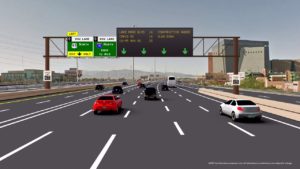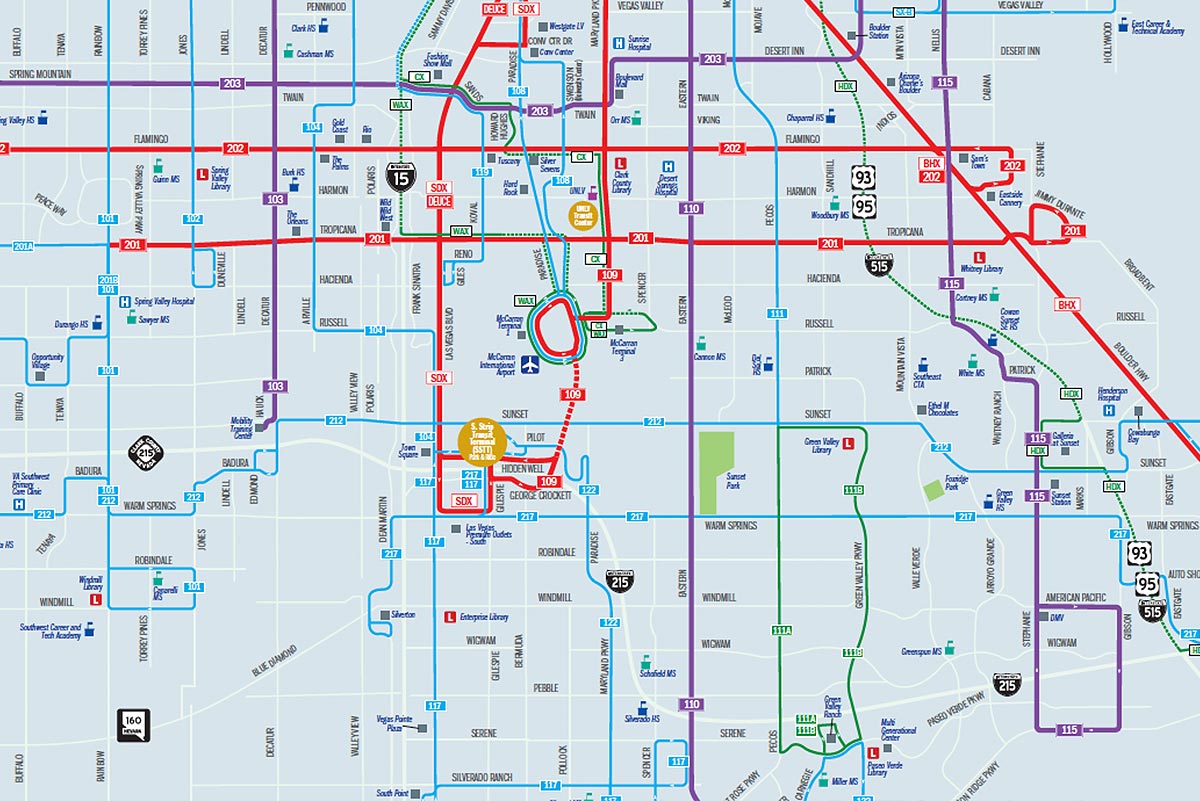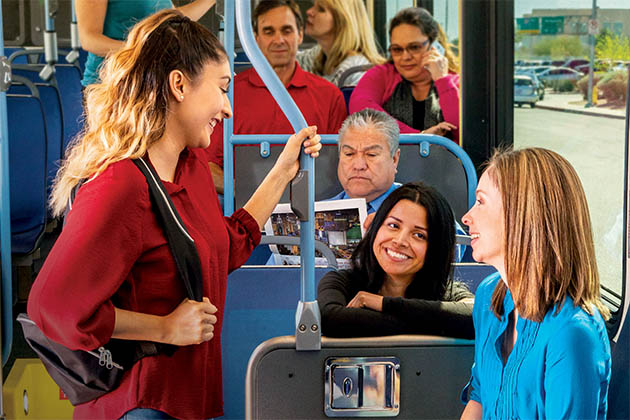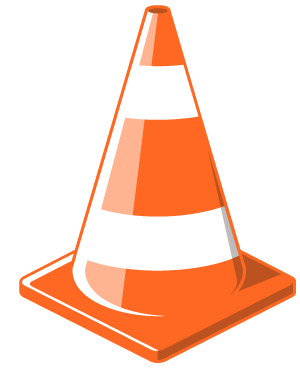About Traffic Management
The RTC’s Freeway and Arterial System of Transportation (FAST) is designed to both monitor and control traffic. The traffic control component of the system consists of freeway and arterial management. Traffic control requires detection of traffic conditions through the use of video image detection and inductive loop detection. Visual verification of conditions is possible through closed-circuit television cameras. Traffic control is achieved through the use of traffic signals, ramp meters, dynamic message signs, and lane use control signals.

RTC staff is responsible for two major areas that make up the FAST system:
- the Arterial Management Section, which includes all arterial streets and roadways such as Eastern, Sahara, and Charleston;
- and the Freeway Management Section, which includes the entire freeway network such as the 215 beltway, US-95, I-11 and I-15.
FAST is under the jurisdiction of the RTC elected board, which makes policies for FAST. Transportation strategies are set by the Operations Management Committee (OMC), comprised of the RTC, Clark County, the Nevada Department of Transportation (NDOT) and the cities of Henderson, Las Vegas and North Las Vegas.
Traffic Signal Operations
The RTC Traffic Management Center (TMC) identifies detours, adjusts traffic signals and keeps vehicles flowing as smoothly as possible for freeway and arterial systems throughout Clark County and the cities of Las Vegas, North Las Vegas, Henderson, Boulder City, Mesquite and Laughlin.
The team manages more than 1,600 traffic signals, 750 arterial cameras, 250 freeway cameras, 160 dynamic message signs/active traffic management gantries, 70 ramp meters and 650 freeway flow detectors throughout the valley.
Learn more by visiting the Frequently Asked Questions below.
Active Traffic Management (ATM) System
The RTC works collaboratively with the Nevada Department of Transportation (NDOT) and Nevada Highway Patrol (NHP) to manage the Project Neon Active Traffic Management (ATM) system along I-15 and U.S. 95. These high-resolution digital displays show real-time information about incidents and lane restrictions in order to improve traffic movement and increase safety by potentially reducing the number and severity of crashes.
Learn more by downloading the ATM fact sheet and FAQs or visiting the NDOT website.
Watch how to navigate the ATM system via the video below:

Did you know?
FAST is one of the first truly integrated Intelligent Transportation System (ITS) organizations in the country. On July 3, 2004, the RTC became the official administrator of FAST. NDOT and the RTC became full-fledged funding partners, contributing to the operations and management of FAST.
Southern Nevada’s freeway ramp meters are a successful joint project of the RTC and NDOT, helping to improve motorist safety and the flow of traffic on the freeway. FAST controls the Las Vegas Valley’s freeway ramp meters on U.S. 95, I-515, I-11 and I-15. The ramp meters are traffic signals with only a red and a green light that control cars merging onto the freeway, and they are consistently monitored by FAST to ensure that they do not create congestion on surface streets.
NRS 484: Traffic Laws
Warning – Traffic violations may result in fines. Failing to stop at a ramp meter when it is in operation is a traffic violation similar to running a red light.
Frequently Asked Questions
Traffic signals run in either fixed-time, actuated, or semi-actuated operation. Each movement at an intersection is called a phase. The period of time it takes to serve all of the phases at an intersection is called a cycle.
When a traffic signal is running fixed-time operations, the duration of each phase and cycle do not vary, regardless of traffic conditions. Signals running actuated or semi-actuated operations use some form of vehicle detection, which senses the presence of vehicles in real-time. Using actuated signal operation, phase and cycle lengths can vary based on vehicle demand and is known as free mode. Semi-actuated operations use a background cycle length and vehicle demand for the side street approaches.
Controlling the flow of traffic through an intersection requires a compromise of numerous considerations. Both fixed-time and semi-actuated operations can be used in a coordinated timing plan along a corridor.
While the different entities (i.e. Clark County, the Nevada Department of Transportation (NDOT), and the cities of Henderson, Las Vegas, North Las Vegas, and Mesquite) own the hardware, the RTC traffic management team controls and operates all of the technology associated with traffic signal timing and coordination.
The entities each use different methods to detect traffic. They include:
- Camera detection – Cameras typically mounted on the traffic signal mast arm, near the traffic signal heads, which use a computer interface to draw detection zones on each lane of approaching traffic. The software then registers vehicles on camera that pass through each detection zone. The camera detection in this area uses either video image or thermal detection.
- Inductive loop detection –Wires typically cut or placed into the roadway surface, which sense the presence of vehicles passing over them.
Note: The RTC Traffic Management Center does not record the footage from the video image detection cameras.
Detectors can be used to determine:
- when a vehicle arrives at an intersection
- when there is a queue of vehicles at an intersection approach (in order to vary the phase duration)
- when vehicles have entered a turn lane (in order to serve that movement)
This may explain why it takes longer for you to get a green signal when you arrive at an intersection.
There are currently over 1,500 signalized intersections in Clark County. This area includes unincorporated Clark County, the cities of Mesquite, North Las Vegas, Las Vegas, Henderson, and Boulder City, as well as outlining areas like Primm and Laughlin.
The signalized intersections in Southern Nevada have a cycle length up to 180 seconds. There are many variables which impact the cycle length, such as the geometry of the intersection, the pedestrian crossing time, adjacent signals, and the time of day, to name a few.
There could be a variety of reasons. Some include issues with detection, such as damaged equipment or sun glare affecting the cameras, or the primary roadway may be running coordination timing plans to move platoons of vehicles along corridors.
Most major roads in Southern Nevada run coordination timing plans, which help move platoons of vehicles along corridors. As you enter and exit major roads from either a right or left turning movement, you are no longer traveling in a platoon of vehicles. Another reason may be due to emergency vehicle preemption, which may adjust cycle lengths to provide a green light to emergency vehicles approaching the intersection.
Notify us through Seeing Orange so we can look into it. Be as detailed as possible, and include the intersection, direction of travel, time of day, day of week, etc. If it is a hardware issue, we will notify the appropriate agency.
Traffic signal timing changes based on the day of week and the time of day, in order to better manage the vehicle demand.
To understand the benefits of ramp meters, think about what happens when you merge onto an already crowded freeway. Many cars try to enter and merge at once. Drivers on the freeway are forced to slow down to let cars enter from the ramp, which result in sudden speed changes, backups and accidents. Ramp meters are in use in more than 20 cities and 12 states. They have reduced rear-end and sideswipe collisions by more than 30 percent in some cities. Travelers can anticipate an overall reduction in travel time with ramp meters as each driver waits slightly longer to enter the freeway, but freeway traffic is smoother and overall speed increases.
Computers and cameras on the ramp and freeway determine how quickly drivers may safely enter the corridor. To do this, the equipment measures freeway traffic speed and volume and ramp traffic.
Pull up to the white line
Drive your vehicle all the way to the white line painted on the pavement next to the ramp signal. Make sure you can see the signal, and be alert as the signal will change more rapidly than a signal at an intersection.
Wait for the green light
When the signal turns green, one car per lane (with some exceptions for two cars per green) may drive along the ramp and merge safely onto the freeway. It is important to red and follow instructions on the signs.
Use both lanes where available
Some freeway entrance ramps have more than one travel lane and each lane is controlled by its own signal. Use both lanes if indicated and abide by the signal controlling your lane of travel.
Cars waiting at a ramp meter will not be allowed to back up onto local streets. If the ramp meter software senses a backup, the ramp signal cycle will be increased to allow cars to enter the freeway at a faster rate. If that is not enough to relieve the backup, the meter may be turned off.
Overall, ramp meters and carpool lanes are important traffic management tools that reduce accidents and keep traffic flowing on the freeways. Management of the region’s transportation system is necessary with traffic congestion constantly increasing (100 cars are added to valley roadways daily). Without that management, there would be gridlock on our freeways and more accidents.
Freeway accidents have been reduced due to ramp meters according to before-and-after studies. The Minnesota Department of Transportation conducted a study of freeway conditions with their ramp meters turned off. All 430 ramp meters in the Minneapolis/Saint Paul area were turned off for six weeks in 2000 and there was a 26-percent increase in crashes with the meters off. Rear-end crashes increased by almost 15 percent, “run-of-the-road” crashes increased by 60 percent, and sideswipe crashes were up 200 percent. Research shows that most freeway accidents occur during stop-and-go traffic due to inattentive drivers. Ramp meters provide a smoother traffic flow, which minimizes stop-and-go traffic.
Waiting time varies depending on how many cars are ahead of you on the ramp. In the slowest situation (a 13-second red and a two-second green cycle), four cars enter each minute on a specific lane. In the fastest situation, 15 cars enter each minute.
Overall, congestion in Las Vegas will constantly grow and that is why the RTC developed a state-of-the-art traffic management system including the use of ramp meters. In addition, the RTC is developing new rapid transit options that will make it easy to travel throughout the Las Vegas Valley.








































